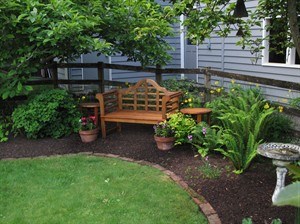
In this June 12, 2013 photo, the lawn remains the centerpiece in this yard but was greatly downsized and shaped by a landscaped perimeter consisting of furniture, statuary and a variety of perennials, in Langley, Wash. Less mowing, less watering and fewer chemicals was the result. It attracts more wildlife, too. (AP Photo/Dean Fosdick)
July 15, 2013 - 7:51 AM
Grass isn't always the best groundcovers for a yard: It's thirsty at a time when water is becoming scarce; it attracts fewer pollinators; it requires expensive chemicals to maintain, and it must be disposed of if you bag as you mow.
That's why many property owners are downsizing their lawns or simply eliminating turf grass in exchange for something more functional and less demanding.
"We're recommending ecosystem changes provided by a more productive landscape, instead of a monoculture from grass," says Susan Barton, an extension horticulturist with the University of Delaware. "A lawn should not be a default vegetation, but it should be more purposeful. More diverse."
She suggests four alternatives to turf grass: landscape beds, meadows, woods and paved, permeable hardscapes.
"All of these provide more ecologic service," she says. "We're talking clean water. More habitat for insects. More oxygen taken in and less carbon dioxide given off."
Barton helped get a county landscape ordinance passed a decade or so ago allowing "managed meadows" to replace grass in residential front yards. These no-mow areas filter water, encourage the return of native plants that provide food and cover for wildlife, and still have curb appeal.
"A managed meadow isn't simply a matter of letting your grass grow long," she says. "It means mowing paths through it and adding edges where needed. If people think about it and make it look good, there's no reason why it shouldn't be part of suburbia."
Downsizing or replacing turf isn't simple or cheap, but it can be done in stages. Start with your toughest-to-grow or hardest-to-mow sections.
"Use the 80-20 plan where 20 per cent of your area requires 80 per cent of your maintenance," says Evelyn Hadden, a founding member of the Lawn Reform Coalition and author of "Beautiful No-Mow Yards" (Timber Press, 2012).
"Hillsides are a good example," Hadden says. "The steeper they are, the more difficult they are to mow. Replaced with the proper plants, they can moderate (water) runoff."
Other replaceable options include boulevards, driveways and pockets overgrown by weeds or moss.
"Look first at areas where the grass is already suffering — "that strip along the street that's hard to water or trampled by people getting off the bus," says Pam Penick, a garden designer from Austin, Texas, and author of "Lawn Gone!: Low-Maintenance, Sustainable, Attractive Alternatives for Your Yard" (Ten Speed Press, 2013).
Use ecological grasses if you don't want to eliminate turf, Penick says. "Fine fescue lawns grow slowly and can get by with less rainfall and less mowing. Those are good options for people who want to fit in with their neighbourhoods but don't want to be slaves to their lawns," she says.
Or "consider ornamental grasses," she adds, or "some of the new groundcovers (aromatic herbs, succulents, low-growing shrubs, ferns, hosta). Edibles. Larger shrubs. You can have a nice looking yard yet be conservation-minded."
Any lawn renovation project should be regionally appropriate, however.
"What we're really talking about is using native vegetation," says the University of Delaware's Barton. "Xeriscaping is a great concept for the Southwest or areas that are dry, but those kinds of plants would drown here. Rain gardens would be a better addition given the amount of moisture we've had recently."
___
Online:
For more about reducing or eliminating turf grass in lawns, see this Penn State Extension fact sheet: http://www.extension.psu.edu/natural-resources/wildlife/landscaping-for-wildlife/pa-wildlife-5 .
You can contact Dean Fosdick at deanfosdick@netscape.net
News from © The Associated Press, 2013